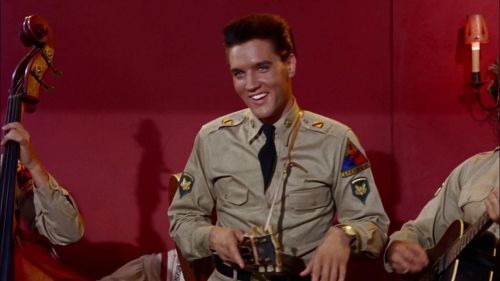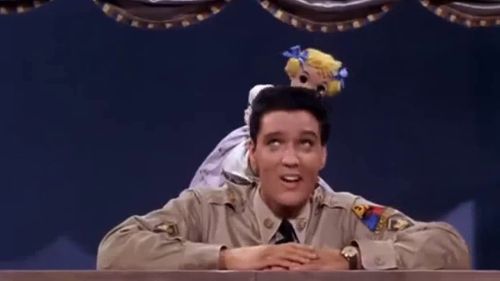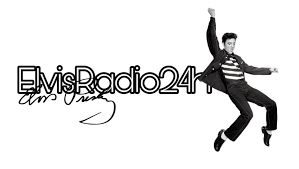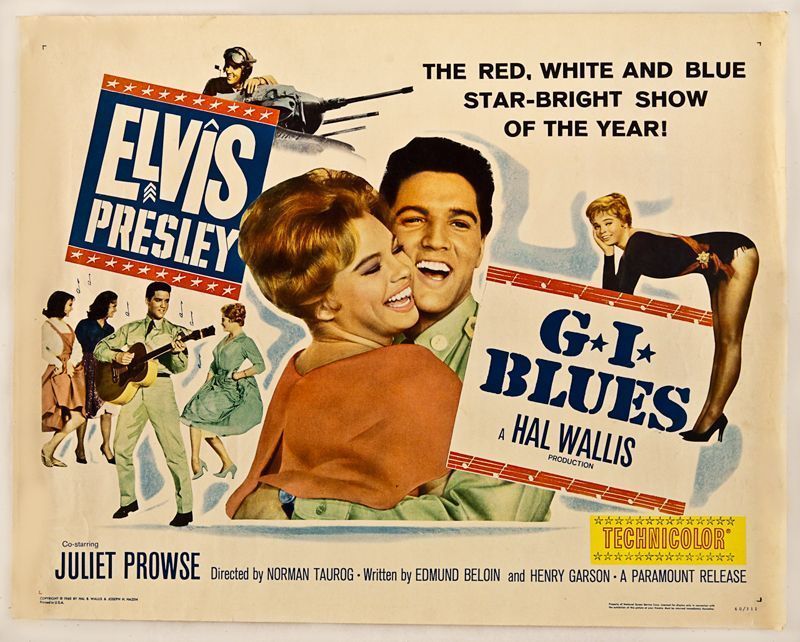
GI Blues
– See the new Elvis!-
(Part 7)
By Mariusz Ogieglo
Further recordings were made only the next day.
The session with the same musicians, vocalists and technicians began with the sounds of the instrumental “Whistling Blues” (not used in the film) around half past one in the afternoon. Then the band recorded several, also instrumental, approaches to the composition “Tonight Is So Right For Love” (of the four attempts played, only the last one, described as master, was complete). The same one that Elvis tried to record the night before.
The first new song – and also the first in which Presley got involved – was the children’s lullaby “Big Boots” written by Sid Wayne and Sherman Edwards. It is worth noting that its initial version had little to do with a children’s song and it is difficult to imagine anyone falling asleep to it. The musicians present in the studio transformed the song into a fast rock’n’roll that would take many couples to the dance floor instead of hitting the pillow. ” I was impressed by the songs from ‘GIBlues’ ,” said Ray Campi, who claimed to be present in the studio that day. ” At the time, I thought they were well written and well arranged .”
The song prepared in this way was repeated at least seven times. Only later did work begin on its proper, free version. ” While ‘Big Boots’ is considered the recording that caused Elvis the most problems, the slow version is absolutely stunning ,” raved Piers Beagley of Australia’s Elvis Information Network. “ Especially when Elvis sings ‘So sleep little solider, don’t you cry, do, do, do, do, do, do, general sandman soon coming by, do, do dooby do’. Elvis’ intonation is pure and clear and you truly feel a joy in listening to him .
ELVIS PRESLEY RADIO 24h
Despite this, the master version obtained after four attempts did not meet the expectations of both Presley and the film studio people because, as Ernst Jorgensen explained in his book, ” the vocals sounded too flat and dry “.
In this way, “Big Boots” joined the list of unfinished songs, which from the previous day included the composition “What She Really Like“. A song that took several long minutes of the session to perfect.
In order to get the right sound, Elvis and the group of musicians accompanying him organized a marathon in the studio, repeating the song over and over as many as fourteen times! * Most of the takes were ” super smooth and were sung in a similar style ” and in a few of them Presley even tried to imitate his idol, Dean Martin. The singer decided to introduce changes to the melody line only after consulting the music director, Charles O’Curran. Just before the eleventh attempt began. ” Actually, the more Elvis sang, the better he looked ,” O’Curran recalled of his sessions with Presley. “ He warmed up before every job. He also never spared his voice and started every song with the same vigor .

Changing the arrangement turned out to be the right move. Describing one of the subsequent rehearsals, Piers Beagley noted that ” in the thirteenth attempt, Elvis abandoned Dean’s (Martin, author’s note) phrasing, which made the song more effective .”
Ultimately, the recording process of the song “What She Really Like” ended after (taking into account the numbering from the previous day) nineteen takes and repeating its problematic fragment three times. The master version was assembled from the last rehearsals – the nineteenth and third working fragments of the recording (described in the documents as the twenty-second take).
” It’s hard to even imagine what kind of perfection Elvis was striving for because he sang most of the approaches simply beautifully ,” said Piers Beagley, who I have already quoted many times in his review of the “GIBlues” (FTD) album, describing the next ballad recorded that day.
“Pocketful Of Rainbows“, as we are talking about it, was created by Fred Wise and Ben Weisman and, as Ernst Jorgensen noted, it was a ” more ambitious proposal ” of these authors and its melody ” tested Elvis’s range and sense of rhythm “.
As with the earlier one, “What She Really Like“, it took a long time to record. ” Elvis had different moods ,” said Ben Weisman. ” Sometimes he joked and sometimes he was very serious. Sometimes he would do thirty-two takes just to get into a song and be completely serious, and sometimes he would just joke about it .”
ELVIS PRESLEY GI BLUES
In the case of “Pocketful Of Rainbows” one could get the impression that the twenty-five-year-old singer was striving to achieve an almost perfect sound. ” The first and second approaches delight with their lightness and slower pace ,” wrote Piers Beagley in his studies. ” The first rehearsal fabulously ends halfway through when Elvis, balancing his vocals up and down the scale, misses the note and laughs and says, ‘God damn it, stop it!’ “. And after a while, joking with Charles O’Curran, he says: ” They probably sent it to make me feel better .”
Weisman himself, however, claimed that in writing “Pocketful Of Rainbows” his intention was to create something ” more refined ” than Presley’s existing repertoire and to move him away from the ” average type of songs played in his own style “. ” He really liked that scene where he travels in the cable car with Juliet Prowse ,” explained the co-author of the ballad years later. “ So I tried to get him to play some high notes, some falsetto sounds, and I also tried other things with him. He agreed and even seemed to like it .”
In the scene mentioned by the composer (set against the background of the German wine town of Rudesheim am Rhein), Elvis sang this song in a duet with Juliet Prowse. However, in reality, the audience on the screen did not hear the voice of a popular actress, but of a valued soprano and member of the famous Ray Conniff Singers, Loulie Jean Norman.

After playing the second rehearsal, the musicians briefly stopped working on the composition described above to focus on the great hit of the golden era of rock’n’roll – the song “Blue Suede Shoes” by Carl Perkins.
In the film, the song was supposed to be played from a jukebox, which one of the soldiers, clearly bored with Tulsa and his band’s performance, turns on while they perform the ballad “Doin’ The Best I Can“. And immediately interesting fact, the label on the mentioned device clearly suggests that the singer of the song is none other than… Elvis Presley.
And if so, a question almost automatically arises – why was the original performance from 1956 not used in the soundtrack and it was decided to record a new version? Well, the reason was seemingly quite trivial. In 1956, the vast majority of Presley’s recordings were made in mono, and RCA simply did not have a stereo version of this song.
But these are not all interesting facts related to the recording of “Blue Sudes Shoes“. As Keith Flynn states on his website, the original script assumed the use of another great Presley hit from the 1950s, namely “Hound Dog“, in the above scene. And, interestingly enough, Leiber and Stoller’s composition was intended to be re-recorded for the same reasons as “Blue Suede Shoes“!
Elvis himself, however, wanted to include a completely different song in the film. ” Elvis wanted to do ‘I Got A Woman’ by Ray Charles ,” recalled Gordon Stoker of The Jordanaires in an interview. “ It was then explained to us that it would cost us two thousand dollars to record this song. That’s why Elvis had to step aside. (Filmmakers, author’s note) They wouldn’t even be able to pay that sum because Ray Charles demanded the full amount upfront before the film was even made .
“Blue Suede Shoes“, recorded in just one take, was his next offering. This time accepted by the representatives of the film studio. Mainly because it belonged to the catalog of the Hill&Range publishing house and the conversations with its author regarding its use in the film were extremely positive.
” Elvis re-recorded it (“Blue Suede Shoes,” author’s note) and gave RCA a new stereo master ,” Gordon Stoker explained. ” Scotty Moore and DJ Fontana were present during its recording and the absent Bill Black was replaced by Ray Siegel, who played acoustic bass. Elvis played rhythm guitar. The re-recorded version was seven seconds longer than the original and had a slightly softer sound .
After recording “Blue Suede Shoes“, Elvis did not immediately return to “Pocketful Of Rainbow“, which he had started several minutes earlier, but focused on another song for a short while. The old German melody “Muss I Denn”.
It was this composition, written at the beginning of the nineteenth century in the regions of Swabia, i.e. the ethnic and historical region of Germany, which currently consists of the eastern part of Baden-Württemberg and the western part of Bavaria, that created the basis for the greatest hit of Presley’s fifth film and one of the most frequently covered songs in the history of pop music.

The exact date of creation of the original is almost impossible to determine today. From the preserved documents it can only be established that the second and third verses of this song were written in 1824. A year later, Friedrich Silcher, a composer and collector of folk songs, included “Muss I Denn” in his songbook entitled “Volkslieder fur 4 Mannerstimmen“. The first recording was made by two clarinettists – the duo Pusinelli and Hackert. The first vocal version is attributed to the Austrian composer, Oskar Wagner. It was supposedly made around 1902.
Nearly sixty years later, Ben Weisman and Fred Wise wrote new English lyrics to the song especially for Presley’s film. “ Well, there’s a scene in ‘GIBlues’ where Elvis and Juliet Prowse are watching a puppet show. (Producers, author’s note) They needed a song that would fit it , “Ben Weisman remembered in one of the interviews. “ So we came up with ‘Wooden Heart’ (title ‘Wooden Heart’, author’s note) because it was about wooden puppets. We matched the lyrics to the folk melody that they (the filmmakers, author’s note) wanted to use. And yes, this combination worked .”
Interestingly, the authors did not replace all the German text with English words. In the new version they also used the original German fragments.
ELVIS PRESLEY RADIO 24h
And it was these lines that contributed to several funny mistakes during recording. As a result, Elvis recorded “Wooden Heart” accompanied by accordionist Jimmy Haskell after four short takes.
He later returned to work on “Pocketful Of Rainbows“, the recording of which consumed the rest of the evening. And paradoxically, despite twelve further attempts, it did not bring the expected results.
“ At the end of the day, at first glance, Paramount received everything that was initially expected – acceptable versions of all necessary songs. But I guess no one was happy with the whole thing ,” Ernst Jorgensen summed up another recording session that ended just after 11 p.m. To make matters worse, copyright issues unexpectedly arose for the song “Tonight Is So Right For Love.”
- The numbering from the previous day was retained in the description of the recording, which is why in the documentation from April 28, 1960, the counting of approaches began not from the first, but from the sixth.
Information provided by EP Promised Land (Poland), Mariusz Ogieglo. http://www.elvispromisedland.pl/
If you want to visit more articles about the life of Elvis Presley, enter the following Elvis Radio 24h link: https://elvisradio24h.com/tag/articles Thanks TCB
We remind you that you can also listen to Elvis Radio 24 hours on your mobile phone by downloading our free applications for Android in the Play Store https://play.google.com/store/apps/details?id=com.icreo.elvisradio24h1, and for iPhone in your Apple Store https://apps.apple.com/app/elvis-radio-24h/id6444257119. Thank you very much!!…




